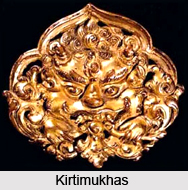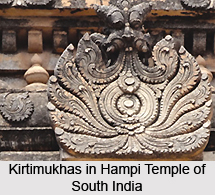 Kirtimukha is an oft recurring motif in the South Indian temples. They have been widely used in the Hoysala temples and others. Kirtimukhas are the `head of glory. ` These elements have been profusely carved on the temple walls. The earliest examples of kirtimukhas are to be found in the ruins at Mohangiri in the Kalahandi and Banei in Sundergarh districts Kirtimukha is also found on the pillars as well.
Kirtimukha is an oft recurring motif in the South Indian temples. They have been widely used in the Hoysala temples and others. Kirtimukhas are the `head of glory. ` These elements have been profusely carved on the temple walls. The earliest examples of kirtimukhas are to be found in the ruins at Mohangiri in the Kalahandi and Banei in Sundergarh districts Kirtimukha is also found on the pillars as well.
The kirtimukhas found in Mohangiri, Banei and Sarsara are the predecessors of the motifs in temple art. An exceptional kirtimukha is found on the Kosalesvara temple at Vaidyanath, Sonepur district. Here the kirtimukha has been sculpted on a brick and from its mouth a bunch of flowers and leaves flow out. There are several such kirtimukhas in the Laksmanesvara temple at Sirpur in Chhattisgarh. Another set of unique kirtimukhas are found on the pillars of the Kosalesvara temple. Here the artisans have shown the kirtimukhas holding a branch of three pearl strings in their mouth and a bell in a chain hanging in between the strings.
At the Kosalesvara temple at Patnagarh the kirtimurkahs appear on the pillars. There are other temples too where one would come across these monstrous faces with bulging eyes. In the sculpture of Kedareswara Temple in Balligavi and the sculpture of Siddhesvara temple in Haveri the kirtimukahs are quite prominent. Amriteshwara temple in Amruthapura and Mahadeva temple in Itagi are also known for their kirtimukhas.  Besides the pillars the kirtimikhas have also been carved out on the lintels of the garbhagriha of certain Indian temples.
Besides the pillars the kirtimikhas have also been carved out on the lintels of the garbhagriha of certain Indian temples.
Till 14th century the kirtimukhas were used as sculptural decorations but after that these disappeared and were occasionally seen on the top of a post or pillar of low height in front of the temples. A temple with such kind of kirtimukhas is the Suvarnameru temple at Sonepur.
Kirtimukha has its origin in a legend from the Skanda Purana. When Jalandhara, a monster created from Shiva, third eye ate his body starting by its tail as per Lord Shiva`s order, who pleased with the result gave it the name face of glory. The Kirtimukha is used as a decorative motif surmounting the peak of a temple or the image of a deity in South Indian architecture. Kirtimukha act as an embellishment over the lintel of the gate to the inner sanctum in many Hindu temples. This signifies the reabsorption that marks the entry into the temple.



